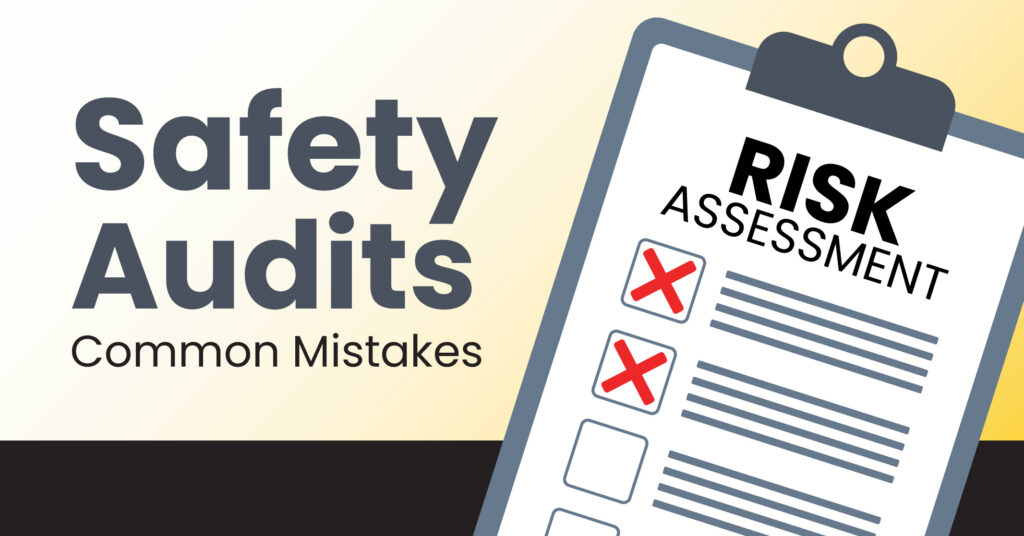
Common Mistakes Seen in Safety Audits
Safety audits play a critical role in helping companies maintain safe work environments. They ensure employee safety, help boost productivity and efficiency, and keep you compliant with your industry’s health and safety standards.
Despite your best efforts, there are still a lot of things that can go wrong. Understanding the potential pitfalls can help you avoid them. Follow this guide to learn more about the most common mishaps and ace your next safety audit.
Mismatched Record-Keeping
Storing some of your records physically and others digitally is a recipe for disaster. The more spread out your documents, the harder it becomes — and the longer it takes — to locate information. You may end up with multiple copies of the same record, each with revisions and edits made by different people. These discrepancies can cause significant issues.
Similarly, a lack of proper organization and labeling can result in an unsafe and non-compliant workplace. These issues can increase the risk of accidents and injuries, which — in addition to the financial cost — can impact employee morale and productivity.
To avoid mismatched records, use one system for record-keeping. Consider moving away from physical records to a software-based solution. Along with making records easier to maintain, going digital can help to save valuable space and avoid lost or damaged documents.
Inaccurate Records
While there might be a lot to do, maintaining safety records isn’t something you can rush through. Inaccurate or hastily done record-keeping results in bad information that can have serious implications for employees. It also leads to failed safety audits.
The consequences of failing a safety audit varies depending on the severity of the issues. In many cases, you may receive a deadline by which you have to fix the noted problems or be subject to a fine. In more serious instances, you may receive an immediate fine. Failure to address the issues on time — or at all — can result in increased fines and legal action.
Accurate records help you avoid compliance issues. They also help you to identify ongoing problems, allowing you to launch a deeper investigation to solve them.
Poor Communication
Effective communication is vital for a safe and healthy work environment. Without it, any efforts to uphold safety measures become useless. The risks of accidents, loss of productivity, and non-compliance all increase. However, communicating too much information at a time, insufficient clarity, or poorly defined expectations can hamper your efforts.
Another common communication issue is a lack of listening. Good communication is a two-way street. Employers and managers need to share essential information with employees. At the same time, they listen to employee concerns and feedback regarding workplace safety. Open communication helps improve safety for everyone and shows your employees that you value them.
Ensure good communication by establishing — and using — communication channels that work for your company. Digital channels, including email, internal communication platforms, and collaboration apps, have become popular options. Centralizing your communications makes them easily accessible and can help prove compliance.
Lack of Oversight
A failure to recognize and manage hazards, even seemingly small ones, means serious accidents are more likely to occur. Things get overlooked no matter how clear and concise your safety measures are. That’s why oversight is so important.
Oversight makes managing health and safety risks easier. Multiple checks and levels of verification ensure that nothing gets missed and that your company accounts for every safety precaution. Similarly, a lack of proper organization and labeling can result in an unsafe and non-compliant workplace.
Safety Audit Checklist
A safety audit checklist is a tool that helps you identify potential health and safety risks and dangers within your company. It functions to help you maintain compliance as well as a safe workplace for your employees.
Your safety audit checklist should be a comprehensive document, identifying all potential risks that exist within your company, including fire hazards, workplace processes, electrical safety, and more. Below are just a few of the vital tasks to check off when you’re preparing for a safety audit.
All Hands on Deck
Workplace safety isn’t the responsibility of only a select few people. While employers and managers should provide a safe place for employees to work, employees also play a role in maintaining a healthy and safe environment. In other words, safety is everyone’s concern.
Preparing for a safety audit means having all hands on deck. Everyone — from upper-level management down to your day labor— needs to be involved in the process.
Materials and Manuals
Every material on-site has a manual as well as regulations to follow. You’ll need to keep these documents in a safe place that allows your employees to access them as well as turn them over to safety professionals when necessary.
PPE Verification
Personal protective equipment (PPE) is a must for minimizing exposure to hazards that could otherwise cause serious injuries or illnesses in the workplace. It includes items such as eye protection, ear protection, masks, and more.
PPE requires constant upkeep. There’s also a lot of room for dysfunctional use. Proper training ensures that all employees know how to use the required PPE correctly, which helps minimize risks for health and safety issues. Make sure you have what your employees need on-site and ensure that they know where to find them. Any PPE required for a specific area or task should be nearby and easily accessible. Place visible signs where necessary to inform everyone within your organization what type of PPE they need to enter a given area or perform specific tasks.
Safety Audits With YellowBird
A safe work environment is a key component of your company’s success. Ensuring safety within your organization helps to boost your productivity and your profitability. It shows your employees that you care about them and reduces the risks of serious accidents, injuries, and illnesses. It also helps your company stay compliant with industry health and safety standards.
Developing a comprehensive safety audit checklist can help you stay on top of potential risks and hazards within your company, allowing you to pinpoint issues and address them right away. If you need help with your checklist, YellowBird can help. Our qualified professionals can perform safety audits to help you identify gaps in your current program and provide recommendations for improvement. We work with you to address hazards before they become more significant problems, helping you create a safer, healthier environment for everyone in your organization.
Are you ready to get started? Visit YellowBird today!





